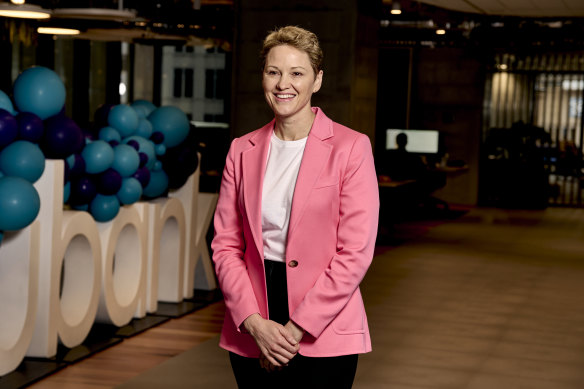This was published 1 year ago
App wars: How banks are trying to win over Gen Z
Connor McCulloch, a 22-year-old salesperson who lives in Newcastle, has many of the banking habits that are typical of his generation.
He doesn’t carry cash, rarely sets foot in a branch and does nearly all his banking on his phone. He is saving up to go on holidays, wants to earn a competitive interest rate, and is open to switching banks to get a higher return.

Connor McCulloch, 22, expects a bank will not only keep his money safe, but also help him keep track of his income and spending.
While being cashless is convenient, McCulloch says having money readily available on a card via his phone makes it easy to spend. So, he expects a bank will not only keep his money safe, but also help him keep track of his income and spending, and how he’s going against savings goals. If a banking app did all these things well, it would be a reason for him to switch to that bank.
“I just want to make sure my money is going where I need it to go,” he says.
There was once a time when banks competed by offering the most ATMs, fee-free cash withdrawals, or by having the largest number of branches. But when it comes the highly sought-after Generation Z customers – those born between 1996 and 2010 – it’s all about apps.
Banks are convinced that Gen Z customers have different expectations of a bank than older generations, as, like McCulloch, they try to keep track of spending that happens digitally, and often occurs via subscriptions such as for Netflix or a gym membership.
‘They are the next cohort to buy a home – that’s a large transaction and that’s a profitable transaction for a bank, so it’s critical to get them on that journey.’
Matt Wilson, Jeffries analyst
As a result, banks are investing heavily in apps that try to give us insights and even tips on how we manage our money, rather than just keeping the money safe and facilitating payments. Banks insist this is a sign of fierce competition – but others are less convinced.
Young people are always sought-after customers, and banking is no exception. Despite a squeeze on margins in home loans, retail banking is still the core source of profits for the local industry, and bankers hope that winning a customer in their 20s gives them a better chance of one day selling them a home loan.
Jeffries analyst Matt Wilson says: “They are the next cohort to buy a home – that’s a large transaction and that’s a profitable transaction for a bank, so it’s critical to get them on that journey.”
There are, however, key differences in how people from different generations tend to do their banking.
Banks say young people log into their accounts far more frequently, and they are more likely to be a customer of multiple banks. A 2020 survey from Evans and Partners found Gen Zs were more distrustful of Australia’s banking giants, while banks’ own surveys suggest this generation is particularly exposed to the pressures of rising rents and the cost of living.
In response, banks are engaged in a battle of the apps – jostling to offer features aimed at younger people who are juggling rising costs and hoping to meet long-term savings goals, all without living a life of austerity in their 20s.
Executives from several of the country’s biggest banks point to key characteristics of younger people that are driving the competition to roll out apps and other digital features.
One such issue the executives identify is unintended spending of digital money.
Philippa Watson, chief executive of National Australia Bank-owned UBank, says younger people’s high use of digital payments, subscription services such as Netflix, and buy now, pay later services, can ultimately result in “incremental and sometimes unintended spending”.
“The use of mobile ... tap-to-pay, etcetera, means that money’s moving in and out of their accounts at a higher velocity and with less friction than ever before, which makes it really different,” Watson says.
In response, UBank – which targets 18-to-35-year-olds in particular – is rolling out new features on its app for managing bills in the first half of 2024.
Research commissioned by Bendigo and Adelaide-owned digital bank Up detected a similar trend of potential overspending.
In December, the bank said a survey found 46 per cent of Gen Z blamed “overspending” for a lack of saving. The survey was conducted via the Up app, and it took in more than 54,000 respondents.

Phillipa Watson, chief executive of UBank, which aims at 18-to-35-year-olds.Credit: Michael Quelch
Up chief product officer Anson Parker said at a time with home ownership out of reach for many young people, “there may have been a shift in focus” towards using savings on experiences. Youth-focused Up has also rolled out new budgeting features, including attempts to “gamify” savings, by allowing people to receive automated messages every week reminding them to save.
Banks also say Gen Z customers are more likely to spend more time on banking apps, and are more open to using tools that help them track spending.
Commonwealth Bank, which has the largest market share among younger customers, says members of Generation Z tend to log on twice a day, which is almost twice as much as the wider average.
CBA’s executive general manager of digital and customer, Meg Bonighton, says that while other generations mainly use a banking app to check their account balances and manage payments, Gen Z is more engaged with money management tools. The bank’s research suggests people in their 20s are thinking about money goals such as travelling, buying a car, often at a time when they’ve moved into higher paid work. “So, how do I balance that with some of those lifestyle choices that I want to make, as well as thinking about my future?” she says.
ANZ’s managing director of customer engagement for Australia retail banking, Katherine Bray, also says younger people are much more likely to use budgeting apps, and are more open to receiving digital “guidance” on money matters from their bank.
This is probably partly because they are tech-savvy, but also because traditional financial goals such as home ownership are harder to attain for Generation Z than older generations. “What we do find is that young people actually want help and guidance on how to achieve their goals,” Bray says.
Westpac’s managing director of cash and transactional banking, Mandy Rutherford, also says the bank’s research has shown demand for services that allow people to track how much money they’re spending on recurring payments – such as subscriptions. She adds that younger customers are also the biggest users of cashback deals that banks have with retailers. “They’re wanting more than just a transaction account and a savings account,” Rutherford says.
Clearly, banks are convinced that younger people want help managing their finances in a world when digitisation has made it easier than ever to spend.
Banks also insist the wave of investment in new digital banking features – which are particularly popular with Gen Z – is driving competition. But on this last point, the jury is still out.
While there’s no question banks are sprucing up their apps to give people a clearer view of their financial behaviour, some in the market say these digital features are ultimately aimed at making customers more “sticky”, or less likely to jump to a rival.
The Australian Competition and Consumer Commission’s (ACCC) recent inquiry into deposits also failed to endorse the banks’ arguments that the wave of bank app budgeting tools was driving fierce competition.
Ultimately, it found “little evidence of aggressive broad-scale price competition” in deposits, especially from larger banks. It also underlined the banks’ various strategies for acquiring customers who might become “sticky” and therefore lucrative in the future – including among younger people, where banks will sometimes offer savers a higher interest rate.
The watchdog also appeared reluctant to agree with banks that their investments in new digital features, many of which are popular with the young, were pushing competition.
“The ACCC considers that, at present, the availability of a banking app and budgeting, money management and spending tracking tools are relatively standard across banks, as well as a range of other service providers,” the ACCC said.
“Although they may differ, it is not clear the extent to which banks are responding to current or ongoing competition via their apps and budgeting tools.”
The Business Briefing newsletter delivers major stories, exclusive coverage and expert opinion. Sign up to get it every weekday morning.